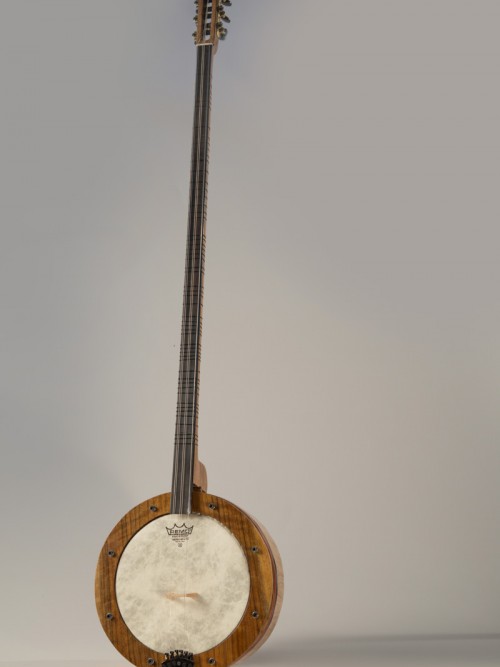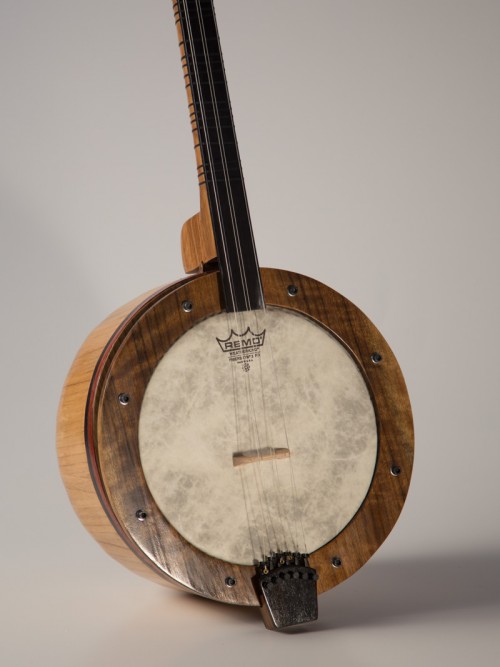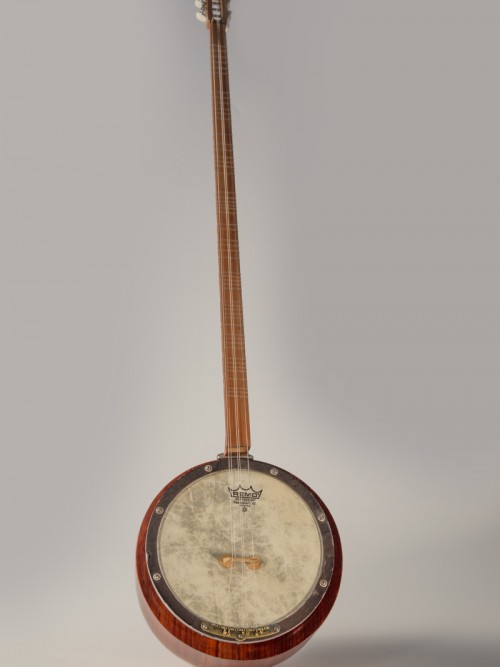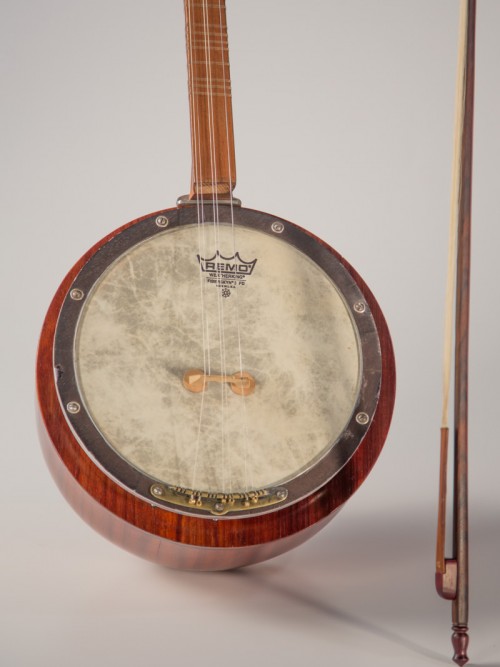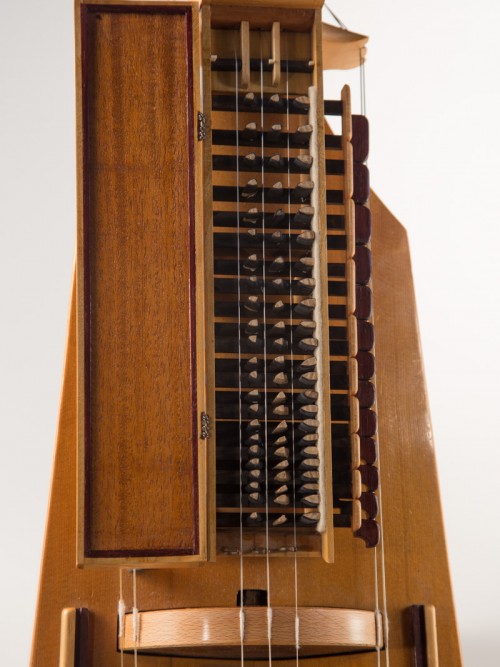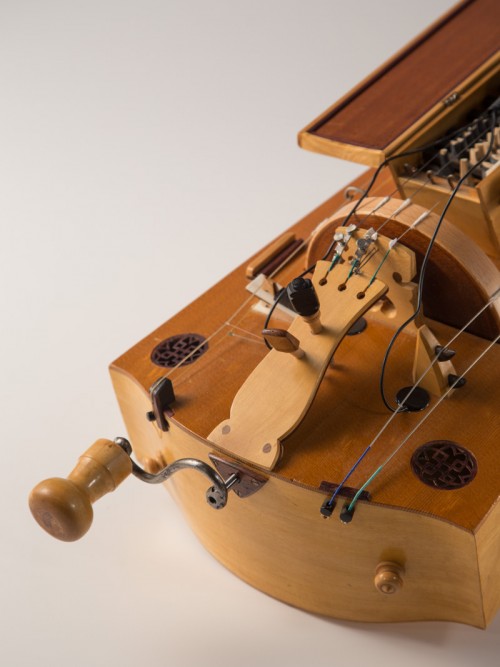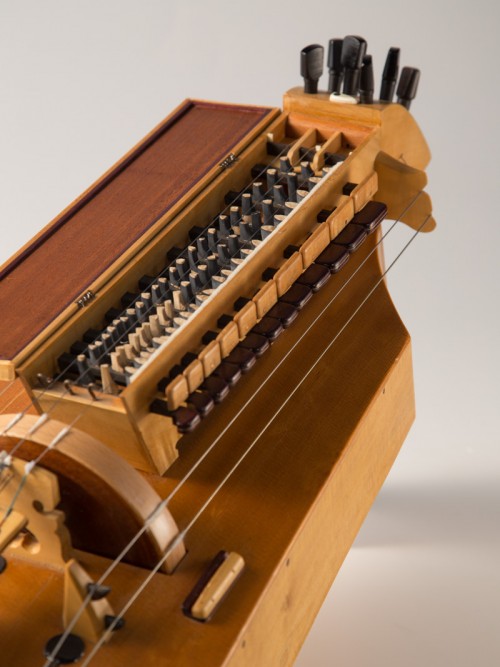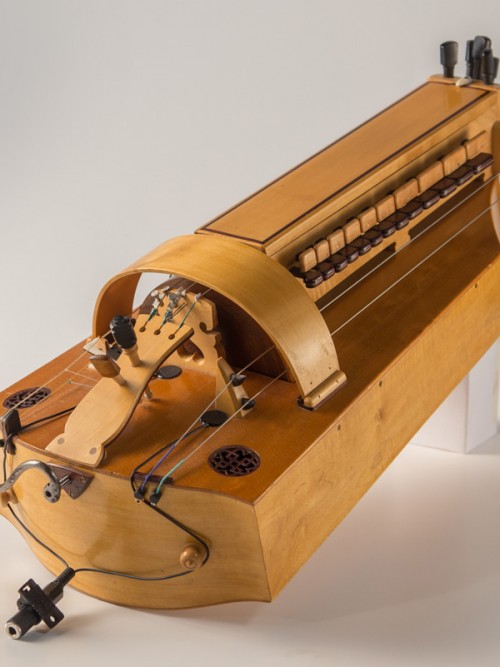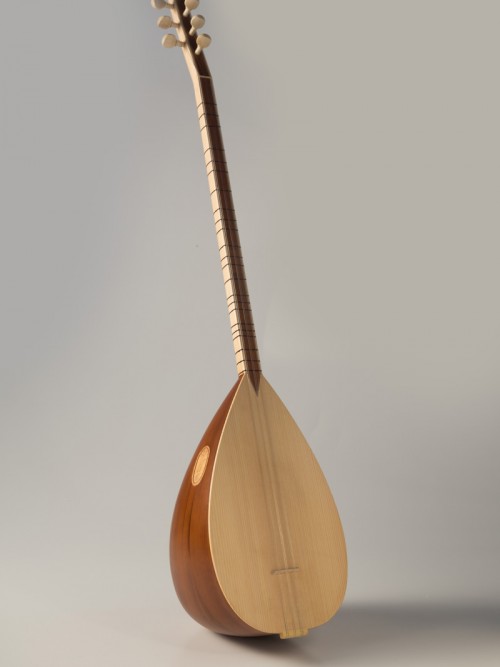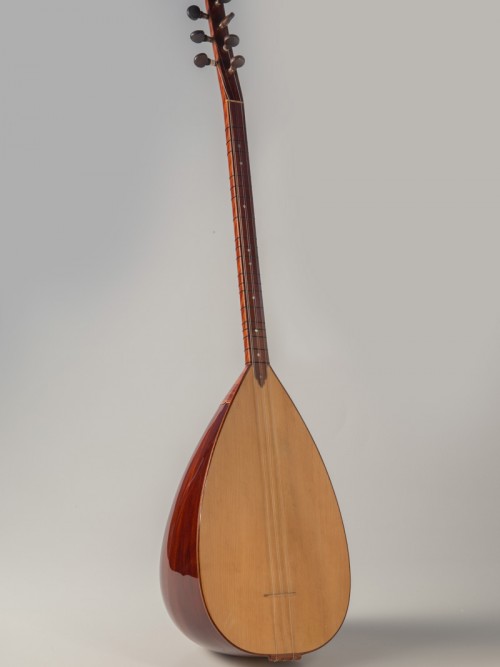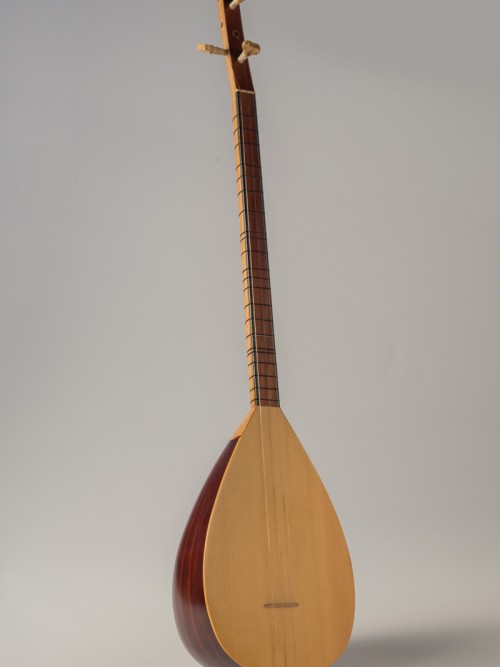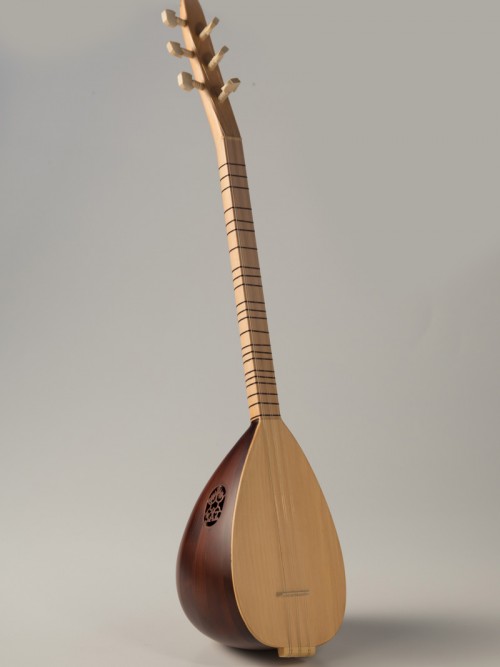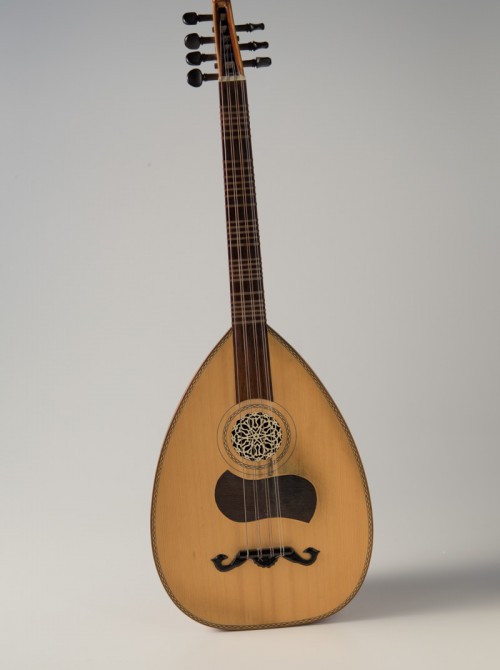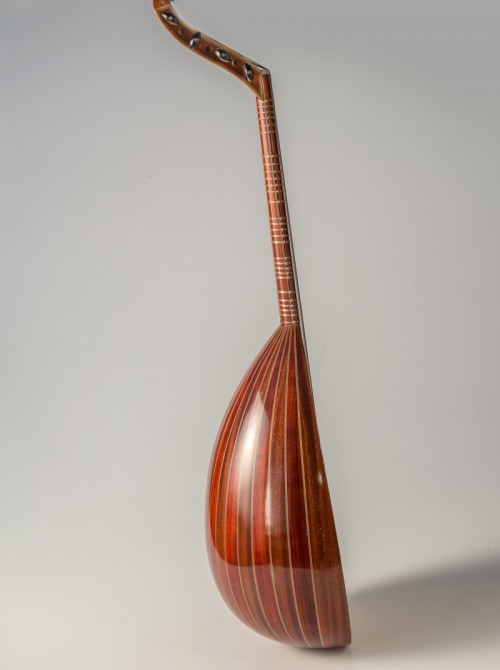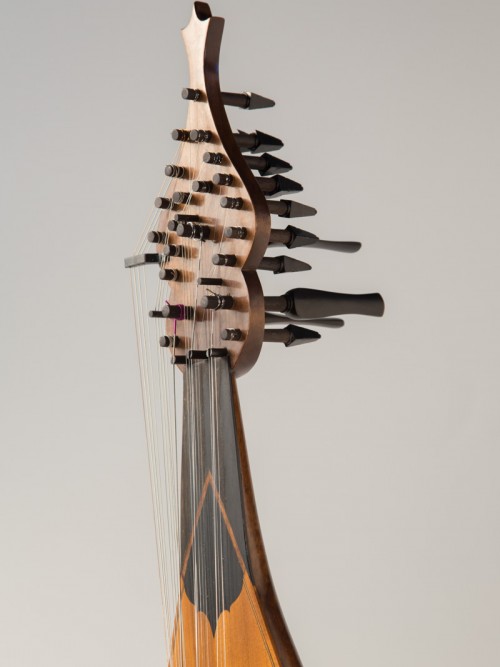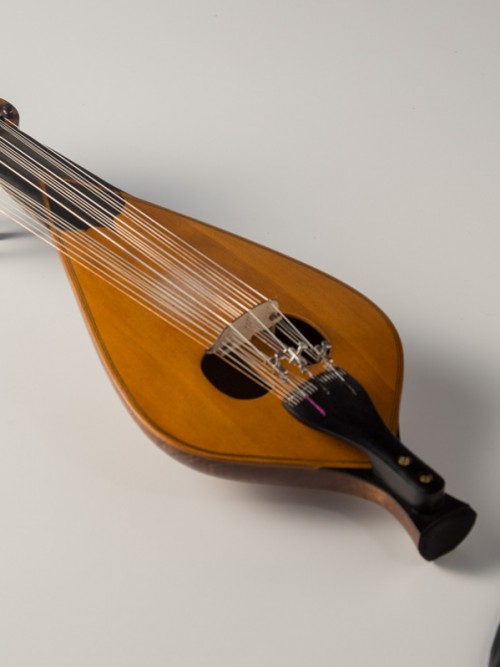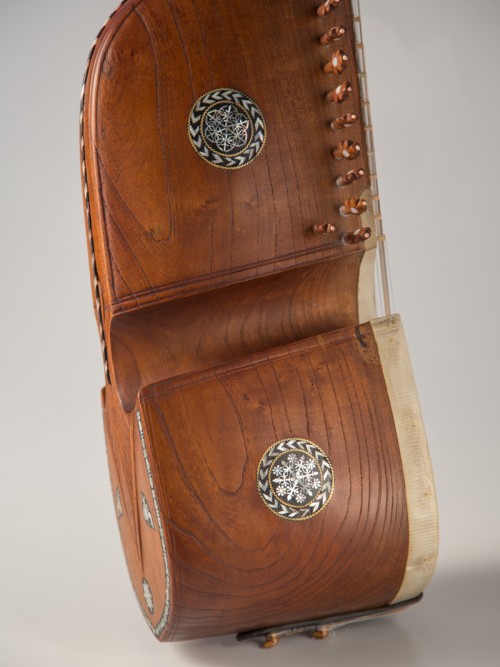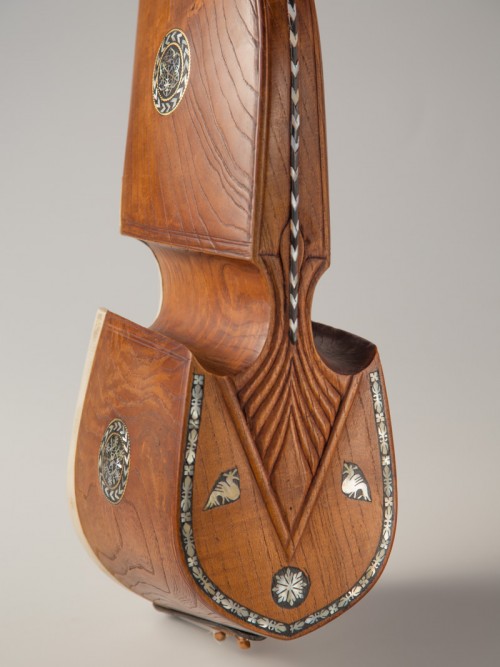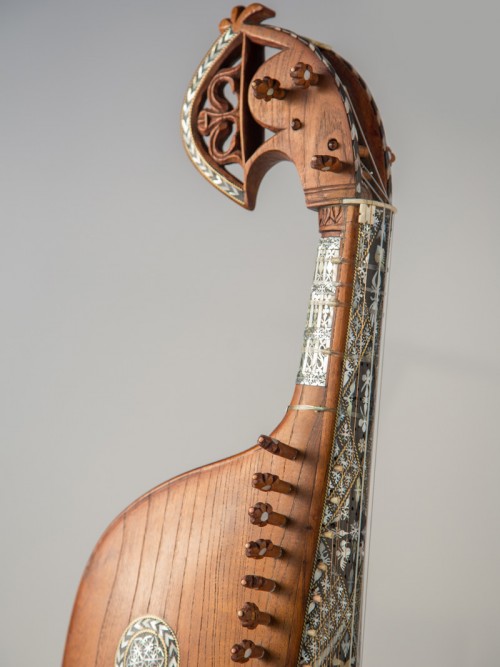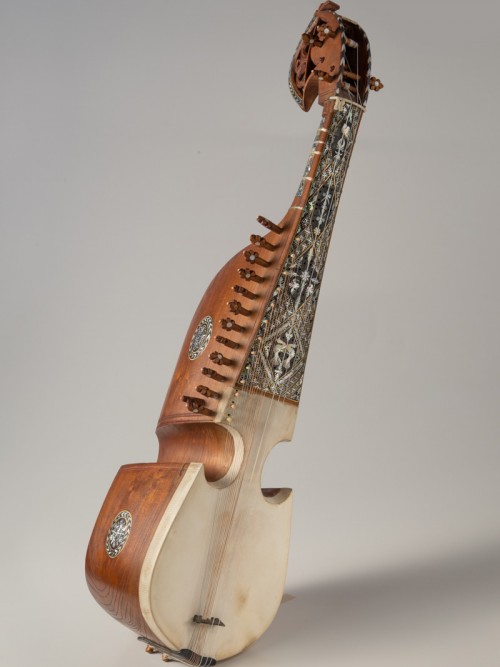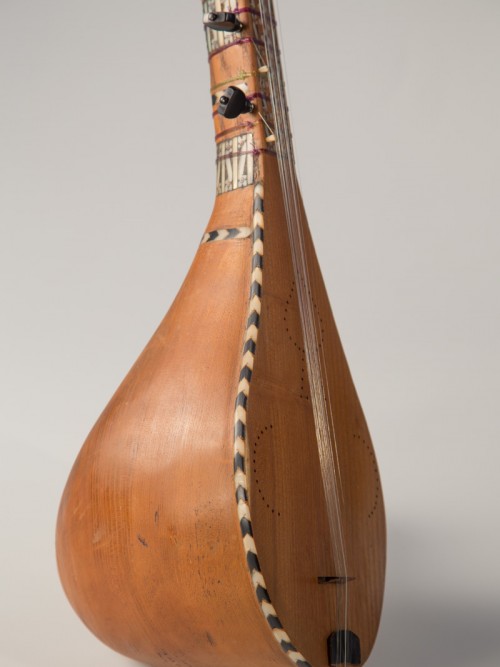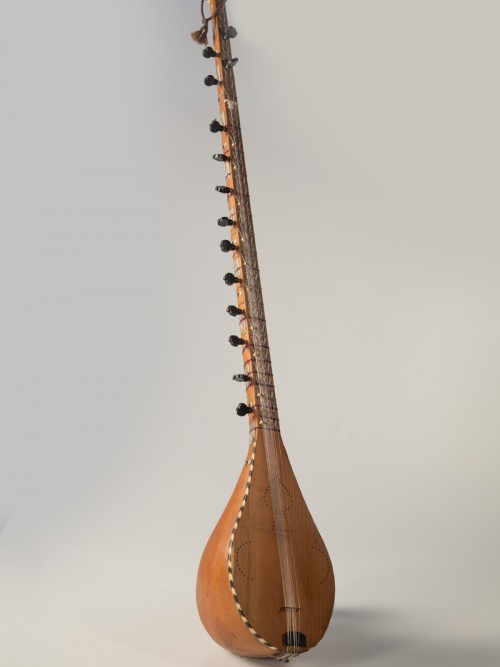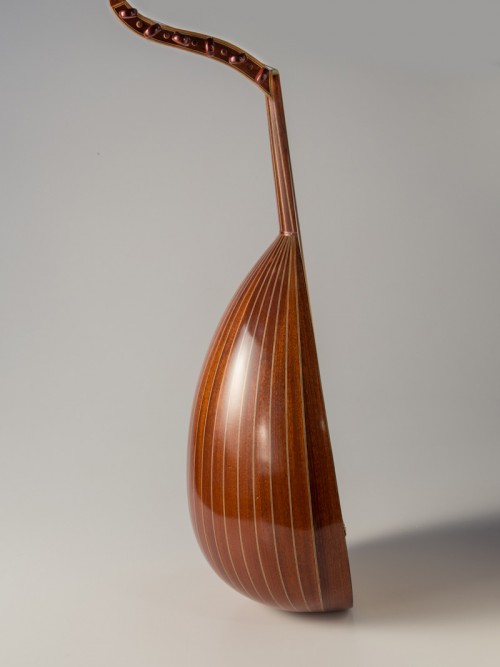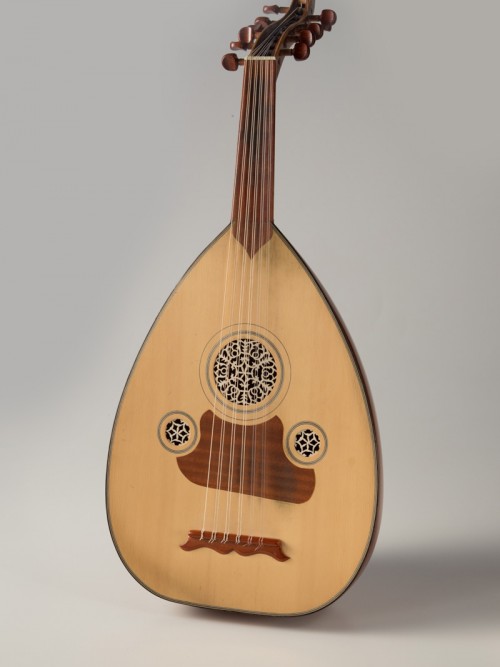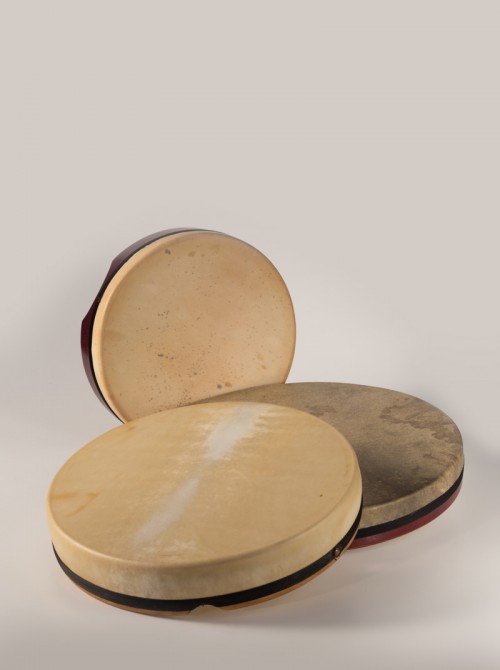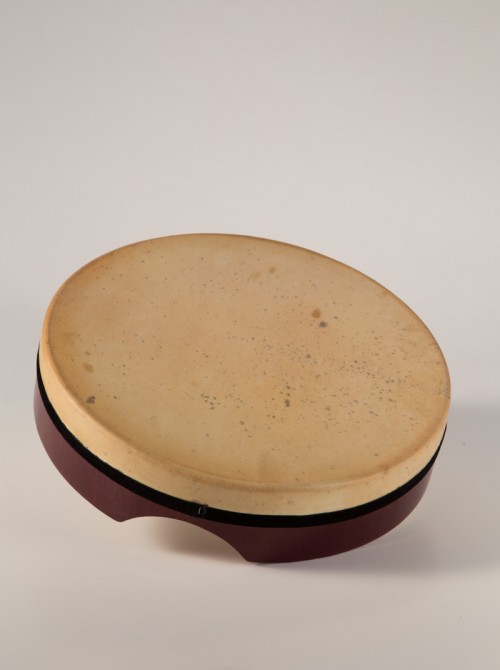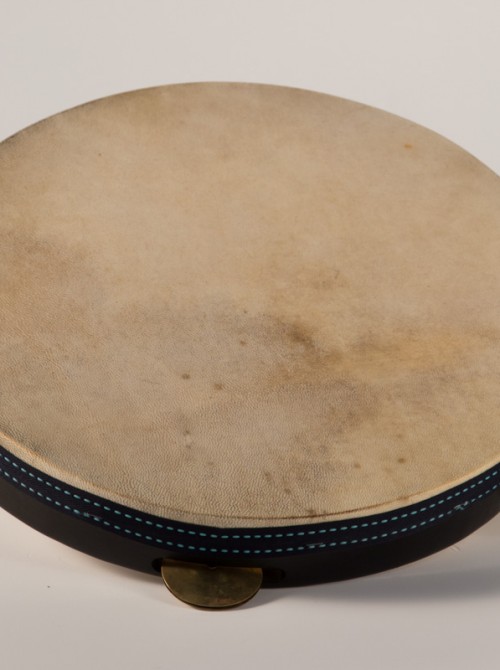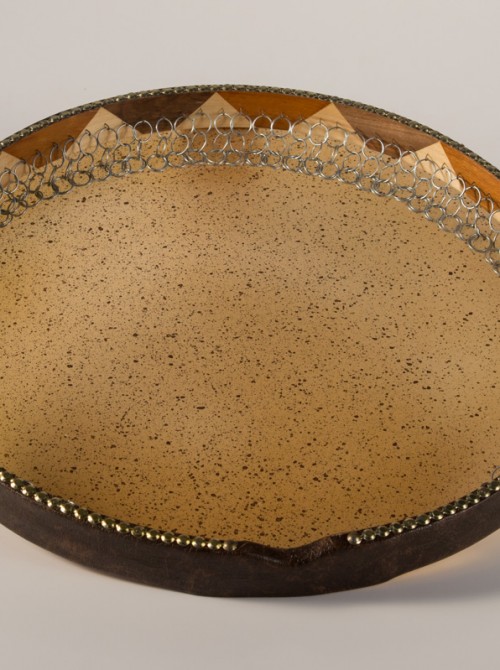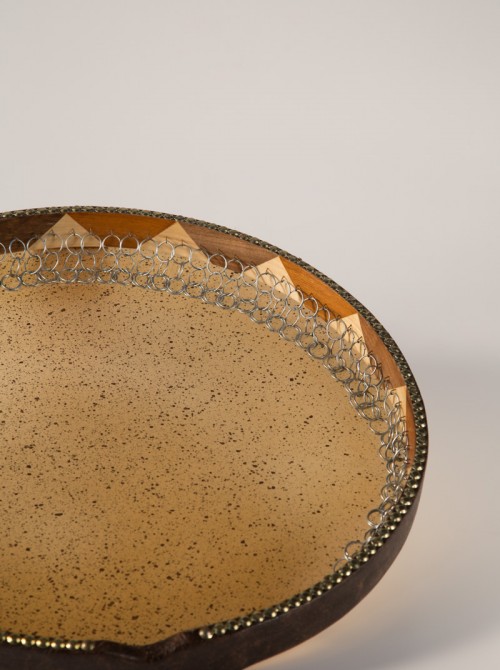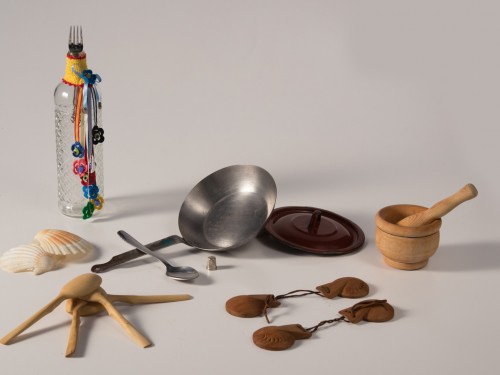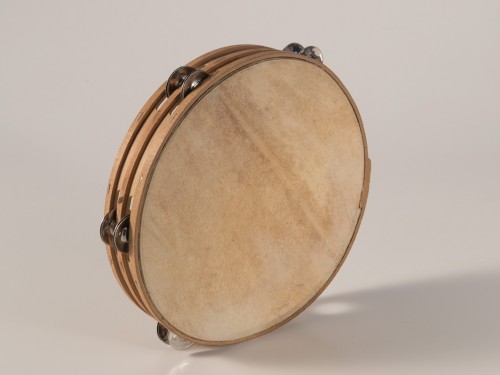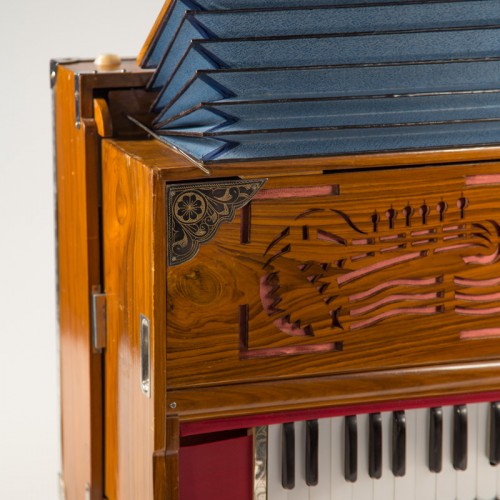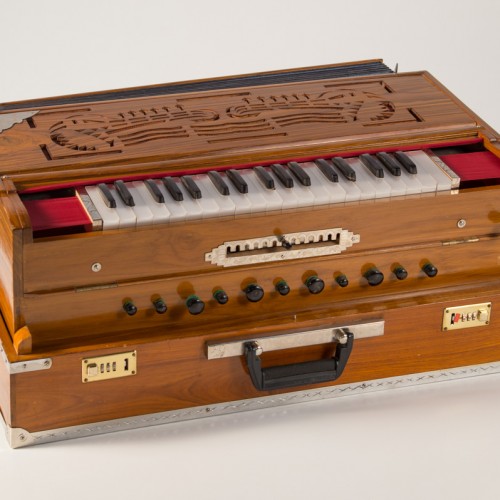YAYLI TANBUR
A string bowed instrument developed at the beginning of twentieth century by the musician Tanburi Cemil Bey from the ottoman pick tanbur.
This instrument is kept raised vertically on the legs and the player pressing only one of the three pairs of strings. The other strings vibrate depending on there tuning and on the harmonics arising within the melody.
The tanbur is considered the most useful instrument to learn the Turkish modal system or makam, since all its frets or perdé are arranged on this wide neck. Those frets are required to perform the microtonal scales of every makam.
The bass Yaili tanbur has recently been created, tuned with a pitch that is one fifth lower.
Renowned tanbur players: Fahrettin Çimenli, Evgenios Voulgaris and again Tanburi Cemil Bey
Luthier: Cengiz Sarıkuş, Carlos Ramírez
Noted performers: Fahrettin Çimenli, Evgenios Voulgaris o úna vez más Tanburi Cemil Bey
Videos: Evgenios Voulgaris
HURDY-GURDY (ZANFONA)
Medieval string instrument.
The strange system employed to rub its strings consists of a wheel which is spun by means of a handle. The melodic strings go through a wooden keyboard. Melody notes are produced on one string, or two tuned in unison, by pressing keys which stop the string at the proper intervals for the scale
There are three different groups of strings:
–Drone strings: they set the modal base.
–Melodic strings: they perform the melody (they vary from two or four strings commonly tuned in A-D or in G-C).
–‘Trumpet or chien’ string: the bridge on which this string rest is not fixed and it allows the string to buzz when higher speed is applied to the wheel. It is mainly used to accent the rythm.
The design of the soundboard in this musical instrument may vary significantly, with the shape of a lute, the number 8 or trapezoidal, as it is the case here.
Luthier: Sedo García
Noted performers: Pascal Lefebvre, Germán Díaz, Efrén López
Videos:
BÂGLAMA
Family of long neck instruments, widely used in countries like Iran, Turkey, Greece or The Balkans.
The name Bâglama comes from the Turkish verb bağlamak that means «to knot» and refers to the frets of the instrument, knotted to the neck. This allows for their mobility to adjust the spacing to the scale or to the mode of interpretation.
Each instrument of this family has a different name related to its size, from the smallest Cura saz through the Çöğür to the bigger Divan.
All of them are built the same way; the body is made from a hollowed out mulberry trunk or created from thin curved wooden blades of different species, called staves. A long and thin neck with fingerboards, usually with ornaments is added to the body. The top of the instrument is straight and usually made of fir wood. The number of strings varies: from two strings in the small iki telli cura saz up to a maximum of 12.
There are many different tuning systems and interpretive techniques which vary amongst the different regions of the country.
Noted performers: Erol Parlak, Erdal Erzincan, Erkan Ogur (kopuz), Mehmet Erenler, Aşık Veysel, Musa Eroglu…
LAVTA, POLITIKÓ LAOUTO
Plucked string instrument from the city of Istambul.
Similar in structure to a small Turkish oud, lavta has got a longer neck and multiple movable frets.
It has got seven strings grouped in four courses tuned from high-pitched to low-pitched (A-D-A-D).
Luthier: Sadettin Sandi
Video: Spiros Delegos
CRETAN LYRA (WITH SYMPATHETIC STRINGS)
There are several types of lyra in Greece, depending on the different regions of the country where these are found: Thrace lyra, Dodecanese lyra and Cretan lyra. All of them are descendant of the Byzantine lyra.
It is preferably made of Lebanon cedar for the top and maple for the body of the instrument.
This model with sympathetic strings was devised by Ross Daly and designed by himself together with Stelios Petrakis. It has been namely Ross Daly who has elevated the Cretan lyra to a high level and has opened its range of performance to countless possibilities.
Ross Daly and Stelios Petrakis, or Kelly Thoma… Other musicians like Iakovos Paterakis or Zacharis Spyridakis are great virtuosos of the traditional lyra without sympathetic strings.
Luthier: Stelios Petrakis
Renowned lyra players: Ross Daly, Stelios Petrakis or Kelly Thoma… Other musicians like Iakovos Paterakis or Zacharis Spyridakis are great virtuosos of the traditional lyra without sympathetic strings.
Videos:
RABAB
Instrument whose origins lie in Afghanistan, also widespread in regions of Pakistan and India.
It is a singular instrument carved from a single piece of mulberry wood.
It has four types of strings:
·Numerous steel or brass sympathetic strings (between 12 and 15), tuned depending on the performance mode or raga.
·Three catgut or synthetic melodic strings
·Two or three metal bass strings tuned in the tonic and fifth mode; sometimes a jawari bridge is used – which produces a drone from the bass strings characteristic of Indian music.
·A high-pitched string chikari is used to emphasize the rhythms.
The mulberry wood fingerboard, which has four knotted frets of nylon, is beautifully decorated with nacre.
The pegbox and sides are also richly decorated with horn and nacre. The harmonic top is made of goatskin and the complex bridge on which all the strings lie is of carved horn.
It is played with a pick or plectrum of wood, horn or bone.
Noted performers: Ustad Mohammad Omar (1905- 1980), Ustad Rahim Khushnawaz (1943 -2010), Ustad Daud Khan Sadozai (1955), Khaled Arman (1963), Homayoun Sakhi (1976).
Video: Ustad Daud Khan Sadozai
HERATI DOTAR, DUTAR, DOOTAR
Etymologically, the term Dotar means «two strings» and is used in countries like Iran or Uzbekistan, to define certain long necked lutes with this feature. In Afghanistan there is a two-string dotar. However, the recent invention of so-called «Herat Dotar» (created in 1960 by Ustad Mohammad Karim Herawi according to Prof. John Baily) has up to 15 strings allocated in a similar manner as in the rabab, i. e. a single melodic string, two or three bass strings, some ten sympathetic strings and a chikari – all of them are metal, steel or brass strings.
The dotar is built only of mulberry wood, from the body – a single carved piece – to the harmonic top, through the neck and the fingerboard, which are finely decorated.
The bridge is usually made of hard wood – rosewood in this case – and sometimes of bone or horn.
The nylon frets are knotted to the neck and are mobile.
A wire plectrum fixed to the finger or a wooden pick is used to play the instrument.
Renowned dotar players: Ustad Gada Mohammad or Ustad Aziz Herawi.
Video:
UD
Its big body and fretless short neck are characteristic of this instrument.
It is used throughout the Arab world, Turkey, Armenia and Iran, where it is called Barbat.
This instrument appears in Arabic texts from the 7th century and has been through many transformations until it became the instrument we know today. In the beginning it was build from a single piece of wood, had four rows of strings and also frets.
Ud players: Yorgos Bacanos (Γιώργος Μπατζανός), Necati Çelik, Yurdal Tokcan.
Luthier: Sadettin Sandi
Noted performers: Yorgos Bacanos (Γιώργος Μπατζανός), Necati Çelik, Yurdal Tokcan.
Video: Yorgos Bacanos
DAVUL, TAPAN
Double-headed membranophone played on its right side with a big mallet and with a thin mallet on its left side, making high-pitched and low-pitched tones possible.
It is used in popular music of different countries such as Turkey, Iran, Armenia, Greece, Bulgaria, etc.
It was traditionally made by hollowing out the trunk of a specific tree, as a walnut or a chestnut tree. Just the circumference of this trunk was preserved to make the instrument.
Video: Arif Sağ
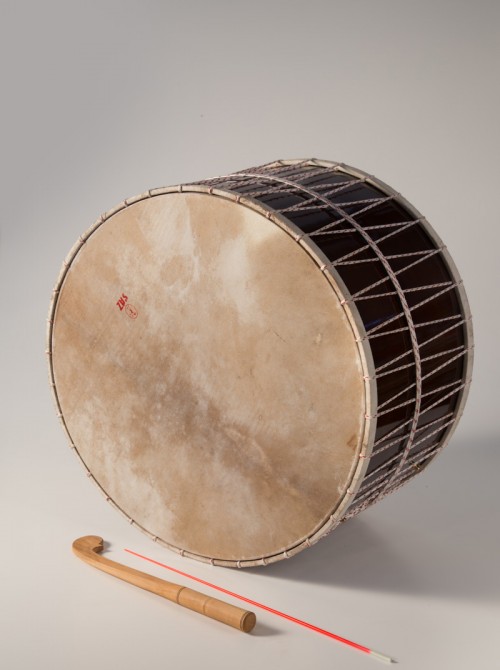
BENDIR, FRAME DRUM
Membranophone formed by a circular wooden frame and a drumhead made of gut or animal skin. It has different names depending on the geographical and cultural region in which is played.
Its origin was established in Middle East. Through history bendir was mainly used in all kind of religious and ritual contexts.
It is played with both hands. Different rhythmical patterns may be performed with bendir, varying culturally. We can find important contemporary performers such as Zohar Frescoö who has developed complex fingering techniques, influenced by Persian and Indian music.
Luthiers: Carlos Ramírez, Diego López, Víctor Barral
Noted performers: Zohar Fresco, Layne Redmond, David Kuckhermann
Video: Zohar Fresco
DAF
Characteristic drum of Middle East, Kurdistan, Iran, Armenia and bordering countries under Persian influence. It is used in popular and classical music.
Similar in structure to bendir, daf is usually bigger in size and has got metal ringlets attached inside to accent the rythm.
The frame is usually made of hardwood and the membrane is usually goatskin, but it is synthetic in this particular case.
Noted performers: Bijan Kamkar, Pejman Hadadi, Mohammad Jaberi
Video: Shekofeh Pariab
PEÑAPARDA SQUARE FRAMEDRUM
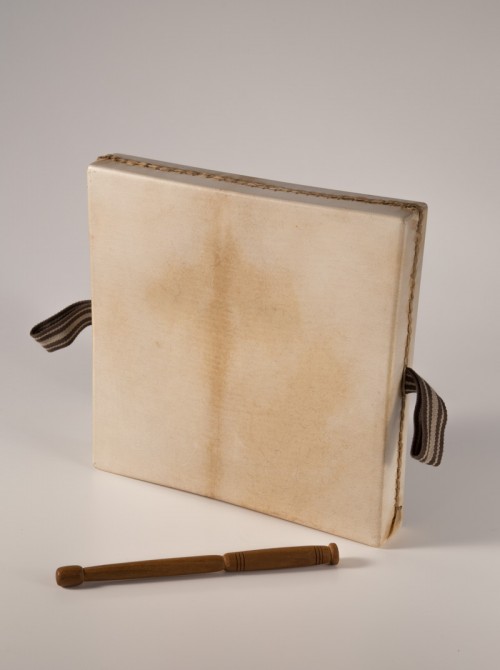
Membranophone characteristic of Peñaparda, a village in Salamanca (Spain). It consists of a square wooden stretcher frame covered by goat skin on both sides. ‘Raberus’ (small pieces of cloth or leather) are added to the frame to introduce your thumb and hold the instrument and also to have a free movement of your hand when tapping it. On the other side of the instrument, a club (similar to the drummer’s one) is used to play it. The way of playing this drum is peculiar. Chickpeas or rattles are sometimes introduced in the structure of the instrument to produce more sound.
It has traditionally been used to accompany the traditional dances of the region. In El Payo, the village closer to Peñaparda, a frying pan is played instead, using the same rhythms.
There are other versions of this square tambourine in Galicia, Asturias, León and Portugal, where it is played just with both hands.
Luthier: Carlos Ramírez
Noted performers: Eliseo Parra, Vanesa Muela, Aleix Tobias
Video: Aleix Tobias
RIQ
It is a small tambourine of Arab origin. It is mainly played in Azerbaijan, Armenia, Egypt, Syria, Lebanon, Iran, Iraq and Turkey. In the past, riq was a musical instrument just for women and it was used in dances and religious ceremonies and also in folkloric dances and songs.
Its diameter is 20cm and it is 6cm high. It has a goat skin (or even fish skin) membrane which is stretched over a wooden frame. It has 10 pairs of 6cm-diameter bronze jingles attached to the frame (called ‘sagats’ in Arabic) and distributed all over it.
Riq is specially appreciated by the variety of sounds which it can produce, always depending on the virtuosity of the musician who plays it. Until the first half of the twentieth century, riq was the only percussion instrument in orchestras but, in the 60s, other percussion instruments were introduced. That was the reason why musicians adopted another technique to play it, consisting on stressing the sound of the jingles much more than the membrane one to be able to stand out over the rhythm. Riq is mainly used in the Arabic classical music to set the rythm of the song.
Video: Zohar Fresco
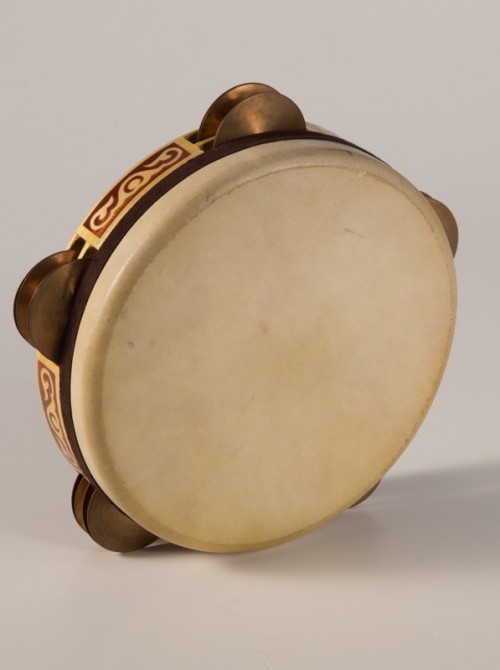
IBERIAN PERCUSSION
Tambourines, spoons, bottles of anisette, mortars and frying pans are some of those small percussion instruments used for years to accompany the songs, dances, serenades in the traditional music of the Iberian Peninsula.
Music is the cultural expression that has always been present in time, regardless of the economical resources possessed in each particular time. That is the reason why people used any kind of object which could produce a sound, when they could not afford to buy a musical instrument. The most common objects used to play are kitchenware.
Luthier: Carlos Ramírez
Noted performers: Eliseo Parra, Vanesa Muela, Aleix Tobias
Video: Coetus y Eliseo Parra
KEMENÇE, KLASİK KEMENÇE, POLITIKI LYRA
A word of Persian origin that defines this instrument being «a little string bowed instrument». However the kemençe is a direct descendant of the Byzantine lyra and there are references to this since the ninth century BC.
Its standard length is 40-41 cm (15.7-16.1 in) and its width 14-15 cm (5.5-5.9 in).
The top is made of cedar wood, different types of hard wood types are used for the sounding board and mulberry, walnut, cherry or maple and ebony woods for the fingerboard.
Strings are usually made of catgut, except for the «Yegah» or C low string, which is usually a gimped string.
The way to play this instrument is by pressing the strings with the nails.
Nowadays this instrument is widely used in the Ottoman classic music ensembles.
Note: This instrument should not be confused with the aradeniz kemençe, pontiki lyra or lyra from the Black Sea.
Renowned kemençe players: Tanburi Cemil Bey (1873 – 1916), İhsan Özgen (1942 – ), Derya Türkan (1973 – )
Luthier: Nuri Kurtul
Videos:
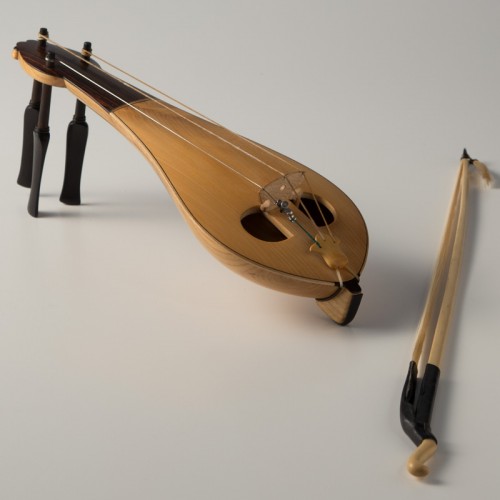
HARMONIUM
Wind musical instrument with a keyboard, native to Germany (XIVth century). It had a great impact on devotional music of India and Pakistan.
It consists of a hand-pumped bellow that makes air pass through all the different spaces within the instrument. Each key controls the pass of air through some metallic reeds which produce the sound. All of this is done by means of valves. It also has a register system activated by handles which allows the pass of air to a specific reed set.
Moreover, this musical instrument has multiple drones and a movable keyboard with allows to play any mode starting from different notes.
SANTUR INDIO
Musical instrument native to Persia adapted in this particular case for Indian music.
It usually consists of 72 strings grouped in trios which rest over small wooden bridges and are tapped with very thin wooden mallets.
It is tuned in raga or the mode which is performed and played sit on your knees.
Noted performers: Shivkumar Sharma, Tarun Bhattacharya
Video: Shivkumar Sharma



